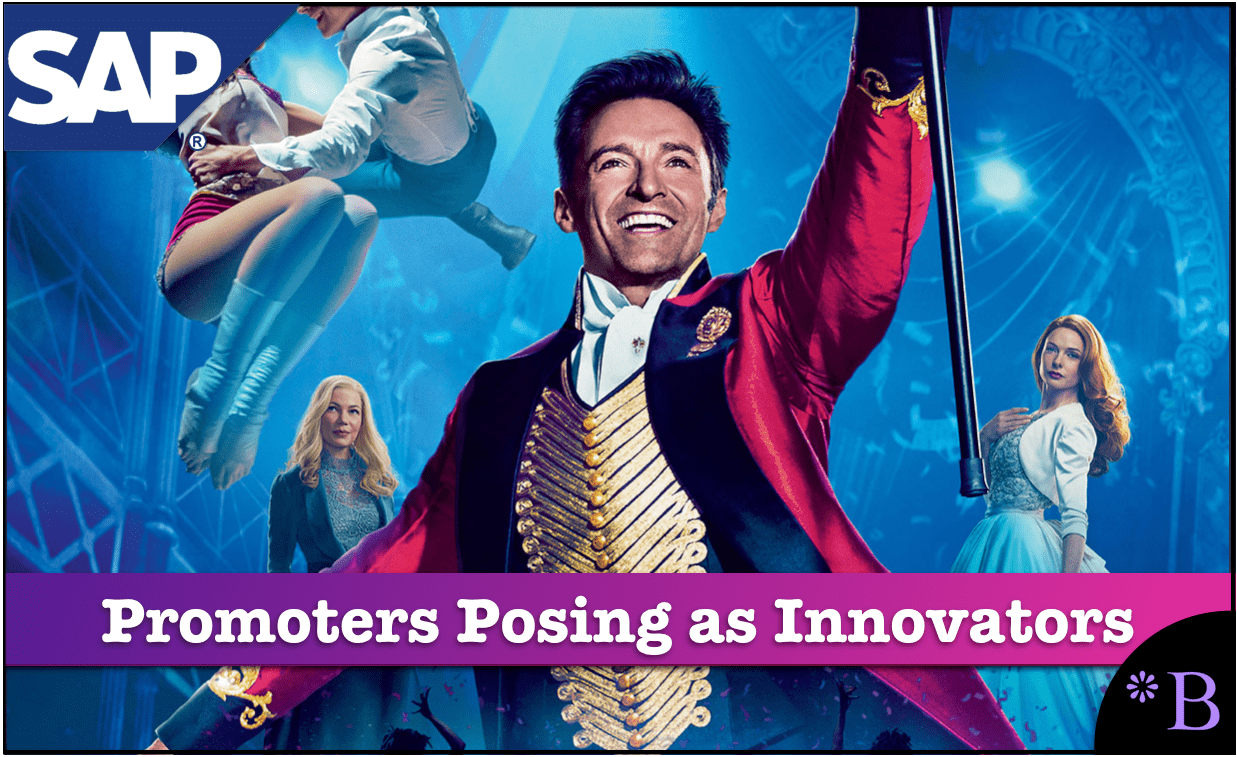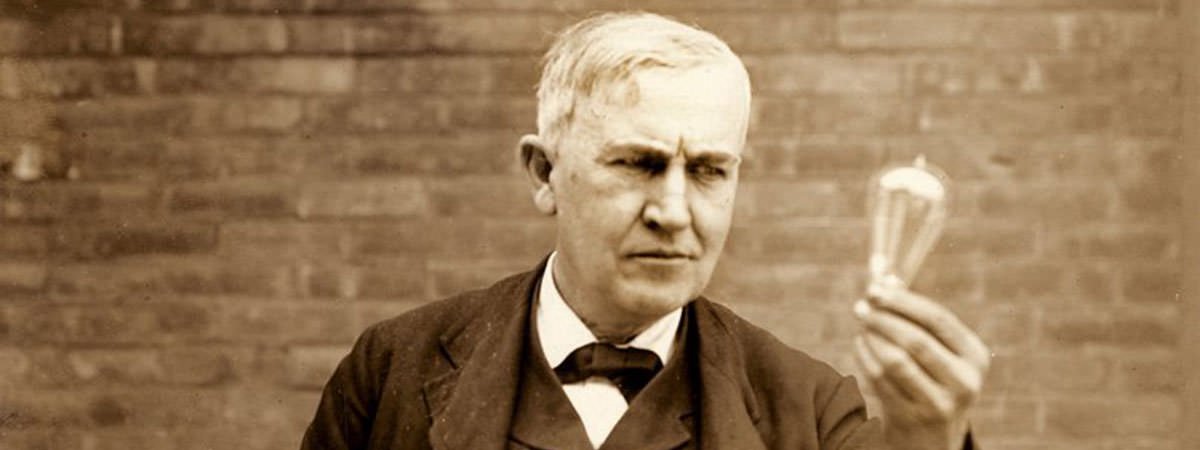Similarities Between Thomas Edison, Elizabeth Holmes and Hasso Plattner
Executive Summary
- After analyzing SAP more than any other research entity, we have come to some important conclusions regarding Hasso Plattner that are not generally known.

Introduction
Companies tend to centralize their coverage around a person who the company puts forward without checking if the person put forward is the individual who is the primary innovator. In this article, we will draw parallels between Thomas Edison, Elizabeth Holmes, and Hasso Plattner.
Thomas Edison
Thomas Edison is often considered one of the most prolific inventors globally, but this conclusion can only be come to if one does not research Thomas Edison’s background. Thomas Edison took credit for making improvements in a light bulb, but this was due to a US patent of British inventory Joseph Swann. Thomas Edison ran a lab where he, as a normal course of behavior, exploited other inventors drawn to his Menlo Park, NJ facility due to Edison’s frequent and high profile coverage in the press at the time. Just the number of patents that Edison accumulated, which was 1093, should raise suspicions about whether these patents were Edison’s from those he employed.
Thomas Edison was a minor technological talent but a major marketing talent. And he determined what image the public was looking for and created it.
“The people wanted a man of singular genius and competence; a man whose ideas and will shaped the world around him; a face that they could put on progress and American technological dominance. And Edison obliged. He made himself into this admirable, heroic figure, at least in appearance, and the people ate it up.” – QualityLogoProducts
Thomas Edison’s savvy control over media caused so many budding scientists to reach out to Thomas Edison and allowed him to steal the inventions of so many people. Thomas Edison has all of these people working in his lab (even Henry Ford worked for Edison). Still, when it came to taking credit, it was all Thomas Edison. Only Thomas Edison was quoted. Only Thomas Edison’s name appeared on patents. This was fake. Thomas Edison was not without his talents. For example, he was a fantastic “packager” of innovation, but he was not himself an innovator. Instead, this was a role that he played for the media.
Although it is essential to point out that taking IP from others and even the credit is the basic model of companies that deal with IP under the work for hire contracts. This, along with exaggerating the IP that one creates, is a common feature of private companies. What is curious is that it is allowed not only for the company to claim the IP but also for them to claim the credit.

Thomas Edison was presented as the actual person doing the work of invention. This was a media construction. Edison was a promoter posing as an inventor. This might have been the first time he held that lightbulb outside of a photo opportunity that week. Edison had a large pool of low-paid employees who were doing the actual work. Let us see Telsa’s view of Edison’s scientific mind.
““His [Thomas Edison] method was inefficient in the extreme, for an immense ground had to be covered to get anything at all unless blind chance intervened and, at first, I was almost a sorry witness of his doings, knowing that just a little theory and calculation would have saved him 90 per cent of the labor. But he had a veritable contempt for book learning and mathematical knowledge, trusting himself entirely to his inventor’s instinct and practical American sense. In view of this, the truly prodigious amount of his actual accomplishments is little short of a miracle.
“Edison was by far the most successful and, probably, the last exponent of the purely empirical method of investigation. Everything he achieved was the result of persistent trials and experiments often performed at random but always attesting extraordinary vigor and resource. Starting from a few known elements, he would make their combinations and permutations, tabulate them and run through the whole list, completing test after test with incredible rapidity until he obtained a clue. His mind was dominated by one idea, to leave no stone unturned, to exhaust every possibility.” ” ―
It should be noted that very few inventors would have had the funding and workforce to test so many permutations. Edison’s lab did have a value, which was to refine the inventions of others. This is the general problem with innovation; those with the financial backing can take advantage of those lacking the resources.
In the present day, intellectual property attorneys, the cost of litigation, and the need that individuals have for employment all combine to constantly move inventions and innovations from the actual creators to those with more financial resources. History shows that those with more wealth have a strong proclivity to steal intellectual property from those with less wealth. Any person who is reading this and who creates innovations should expect that someone with more resources will attempt to take their intellectual property from them—the better the intellectual property, the stronger the likelihood that this will occur. We have met several people in our professional experience who generally believe that IP should be stolen from their inventors by any means necessary.
Let us move to our second example.
Elizabeth Holmes of Theranos
Elizabeth Holmes named her blood-testing device Edison, which was a nod to Thomas Edison. She was also a big fan of Steve Jobs, another promoter known for his marketing and image-making savvy than his technology knowledge. For Elizabeth Holmes’s skill set, Holmes picked her inspirational icons well.
Elizabeth Holmes is now known as a fraud. Still, for over ten years, Elizabeth Holmes raised $900 million through mostly the strength of her vision, her personality, her connections, and her story.
How to Make Zero Progress After 13 Years and $900 Million: Start With Not Knowing Anything
Theranos is an interesting case study in that the company made zero progress towards anything because the original design objectives did not make any sense. This is because Elizabeth had only completed a few college courses in biology before starting Theranos; she did not know enough to know what she did not know.
There are specific reasons why the current blood analysis system is set up as it is, with blood drawn from the vein rather than from a fingerprick. If Elizabeth had studied the topic before starting her company, she would have figured out the reasons.
The entire story around Theranos was fake. Elizabeth Holmes did not have any knowledge to accomplish what she intended she said she would accomplish. Once she began running the company, she did no technical work on Edison but hired people with technical training to perform an impossible goal. However, if her employees had somehow succeeded in doing 100% of the work to get Edison to work, there is little doubt that Holmes would have taken full credit for the accomplishment, and media outlets would have supported her in her claim.

It is easy to be optimistic when you don’t know the subject matter.
Elizabeth Holmes placed her name on a patent in 2003 that it is now widely thought should never have been granted, as is pointed out by the Above the Law.
‘“Holmes’s 2003 application was not a ‘real’ invention in any meaningful sense . . . Indeed, it’s fair to say that Holmes’s first patent application was little more than aspirational science fiction written by an eager undergraduate.” Nazer goes on to note that the patent examiner for one of Holmes’s patents (U.S. Patent No. 7,291,497) did review it closely (for technical issues), but “[w]hat the examiner did not do . . . was ask whether Holmes’s ‘invention’ actually worked.” Holmes was granted a patent for an idea, but not one that could actually be practiced.” Unfortunately, the patent examination system in the United States is overburdened and under-resourced. As I noted previously, “USPTO today is overwhelmed with patent applications and, as a result, patent examiners do not have adequate time or resources to thoroughly examine the applications. The agency receives more than 600,000 patent applications per year and patent holders are constantly pressuring for quicker deliberation in approving their applications . . . Because of the high volume of applications an examiner must process . . . it has been estimated that 70 percent of examiners have less time than necessary to thoroughly complete an examination.” Not only do patent examiners have inadequate time to determine whether prior art exists (remember: patents must reach a “novelty” threshold), but they certainly aren’t equipped to determine whether the invention actually works (meeting a “utility” requirement that the invention is useful and an “enablement” requirement that would allow a person of ordinary skill in the art to be able to build and use the invention; this is part of the patent bargain that grants a limited-time monopoly, but ultimately serves the public good).”
And this following quotation from Ars Technica is genuinely jaw-dropping.
“The USPTO generally does a terrible job of ensuring that applications meet the utility and enablement standards. In practice, unless an application claims an obviously impossible device (like a perpetual motion machine), the examiner will not question whether it works. To some extent, this is understandable. Examiners only have a few hours to review each application, and they can hardly be expected to run complex experiments to check the applicants’ claims. But this practice can lead to serious errors.
Yet more than a decade after Holmes’ first patent application, Theranos had still not managed to build a reliable blood-testing device. By then the USPTO had granted it hundreds of patents. Holmes had been constructing a fantasy world from the minute she started writing her first application, and the agency was perfectly happy to play along.”
How the US’s Broken Patent System (in part) Allowed Elizabeth Holmes to Start Theranos
That patent was used to trick investors, along with Elizabeth Holmes’s other persuasion skills, into investing in Theranos. The assumption was that a patent from the US patent office had been investigated. But as explained, this was a faulty assumption. And Theranos an example of many people who did not do sufficient research before they invested or repeated what Elizabeth Holmes said to them. Theranos received investments from a wide array of powerful individuals ranging from Rupert Murdock to Larry Ellison.
There are several commonalities that we can see between Thomas Edison and Elizabeth Holmes.
- Exaggerating their role in the technical work of invention.
- A corresponding high degree of reliance upon uncredited workers who do the actual work.
- A strong ability to obtain media coverage.
There is another clear parallel that applies to Thomas Edison and Elizabeth Holmes in terms of the environment, even though they were separated by roughly 130 years. Even though the media systems in the late 1800s, an environment dominated by print media and no television or Internet, was quite different from the media environment of the 2010s.
- Media entities were looking for a story that oversimplifies the innovation process and centralizes it to a single person. It should be noted that both Thomas Edison and Elizabeth Holmes were able to pull this off without any education in their fields (although Elizabeth Holmes had the prestige of having dropped out of Stanford).
- Media entities that do an insufficient amount of fact-checking.
- Media entities quickly referred to other media entities, assuming that they had performed the background research, and therefore they did not have to.
The separation of these two individuals by such a long period indicates that this is a constant feature of our media system.
And now we turn to Hasso Plattner.
Hasso Plattner
We have spent hundreds of hours analyzing Hasso Plattner’s writing, his books, comments on blogs, his SAPPHIRE videos, and so on. And from this analysis, we have found some interesting parallels to Thomas Edison and Elizabeth Holmes.
Through our analysis of various SAP topics, we have repeatedly run into inaccurate features around Hasso Plattner. It is impossible to separate Hasso Plattner from SAP. SAP put significant resources into the promotion Hasso Plattner. SAP created a false backstory around HANA, as we covered in the article Did Hasso Plattner and His Ph.D. Students Invent HANA? SAP would have to have known that this story was made up. Hasso Plattner is repeatedly introduced as a “Dr. Hasso Plattner” even though SAP certainly knows that Hasso Plattner only has honorary doctorates, as we covered in Does SAP’s Hasso Plattner Have a Ph.D.?
Hasso has used his phony professorship at an institute called the Hasso Plattner Institute. He started on the campus of the University of Potsdam in Germany to claim that he is “unbiased” in his claims around HANA, as can be seen from the following quotation.
“please stick to the facts and be willing to accept new insights.
i wrote this this blog as a professor of computer science at the university of potsdam and as an adviser in the sap hana project. i am not an employee of sap any more.
any comments are welcome. -hasso plattner”
- Hasso wrote this comment and claimed that he no longer has any connection to or any of his wealth tied up in SAP. Hasso is now completely independent of SAP, and the HPI is not heavily invested in the HANA storyline?
- Secondly, how is Hasso Plattner, a professor of computer science, anywhere? Hasso has no undergraduate or graduate degree in computer science.
Hasso and HANA
HANA demonstrated Hasso Plattner’s lack of technical expertise. Hasso’s books such as “The In-Memory Revolution.”

Hasso made enormous errors when “designing HANA.”
- HANA was initially designed to have no row-oriented tables, and then in SPS08, suddenly what SAP said were not needed (row-oriented tables) were added to HANA as we covered in the article How Accurate Was John Appleby on HANA SPS08?
- Hasso, for some reason, thought databases could be made zero latency.
- Hasso thought that all data could or should be loaded into memory, even though only a small fraction of data within a database is usually processed at any one time. Hasso missed the fact that was loading such large amounts of data into memory lead the processor to spike and become overcapacity, as we covered in the article How HANA Takes 30 to 40 Times the Memory of Other Databases.
The list of design errors made by Hasso on HANA is their article. Still, as with Elizabeth Holmes, Hasso never put the work into sufficiently study databases to understand what was possible. Like Elizabeth Holmes, he was a promoter who was pretending to be an inventor.
Hasso and ERP
Hasso Plattner and SAP have expanded into many software categories since the late 1990s, but SAP has not effectively developed applications in any of them. SAP’s most popular internally developed application outside its flagship ERP system is BW or the business warehouse. However, it is one of our lowest-rated applications, as we covered in the article Could SAP DP or BW Survive as Independent Products from SAP?
The common idea is that SAP may have inferior products outside of their ERP system, but their ERP system is very “solid.” However, there is a problem with this storyline as well. When we reviewed the academic literature on the ROI of ERP systems, we found that for decades academic studies have not been able to find any ROI on ERP systems. We cover this topic in detail in the book The Real Story Book on ERP. And SAP has the most expensive ERP implementations in the industry. For more information, see our article How to Understand The High TCO and Low ROI of ERP. Because of this high average cost of SAP ERP implementations, in the vast majority of cases, SAP customers lost money from their SAP ERP implementations. The information regarding the lack of ROI from ERP systems is publicly available. Yet, there has been no financial incentive to inform buyers of this reality because the industry, which is made up of vendors, consulting firms, IT analysts, and media entities, are financially incentivized to continue to push ERP systems.
But the situation is worse than this.
The reason is that by implementing SAP ERP systems, SAP customers often ended up purchasing other systems that connected to the ERP system that was always a step down from the ERP system. And the ROI from those connected systems (BW, APO, MDM, PLM, etc..) was significantly negative. This means that every customer that purchased SAP was worse off than if they had never obtained anything from SAP.
Conclusion
Like Thomas Edison and Elizabeth Holmes, Hasso Plattner is not an innovator. He is a promoter who has been positioned by SAP as a substance when he isn’t. SAP has done this because it fits within the media’s interest in finding “one person” who they can say is the brains behind a company.
Hasso Plattner significantly reduced his credibility with us the more we analyzed his writing over the years. Hasso not only can’t write, but he is also incapable of writing in a structured manner. He is also quite mentally lazy and does not research the items he speaks about before writing.
All of this means that Hasso Plattner has been visiting companies and has made impressions on people based upon his fame, and people have been looking for answers from a person who does not have any. He is not what SAP says he is, what the media says he is, or what SAP resources or executives think he is. What Hasso Plattner is, is a highly effective promoter. But his ability to effectively promote is based upon a false background as to his technical knowledge.
References
http://theconversation.com/thomas-edison-visionary-genius-or-fraud-99229
https://arstechnica.com/tech-policy/2019/03/theranos-how-a-broken-patent-system-sustained-its-decade-long-deception/
https://www.ranker.com/list/things-edison-claimed-to-have-invented/melissa-sartore
*https://abovethelaw.com/2019/03/elizabeth-holmes-and-the-great-patent-scam/
https://medium.com/@asandalis/law-7-get-others-to-do-the-work-for-you-but-always-take-the-credit-e58829dd670d
*https://boingboing.net/2019/03/04/weaponized-design-fiction.html
https://www.quora.com/I-hear-many-people-claim-Thomas-Edison-was-a-fraud-and-cheat-Is-that-true
*https://www.darkintelligencegroup.com/the-dark-report/laboratory-management/pathologist-raises-questions-about-theranos-business-model/
*https://www.qualitylogoproducts.com/blog/thomas-edison-self-promotion/
https://en.wikipedia.org/wiki/List_of_Edison_patents